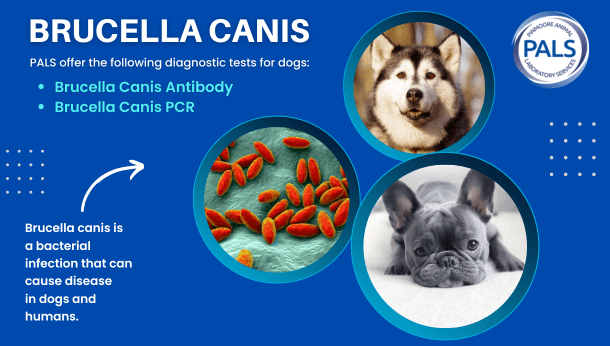Brucella Canis: Symptoms, Causes & Treatment in Dogs UK

Brucella canis is a bacterial infection that affects dogs worldwide and has become increasingly significant in the UK in 2023. This bacterium primarily targets the reproductive system, causing infertility, abortions, and stillbirths in breeding dogs. Awareness of brucella canis is crucial for pet owners, breeders, and veterinary professionals, as it can spread silently and remain undetected for months.
Although primarily a canine disease, brucella canis carries zoonotic potential, meaning humans can rarely become infected through contact with infected dogs or their bodily fluids. Understanding how brucella canis spreads, its symptoms, and available treatments helps dog owners take proactive measures to protect their pets and reduce potential risks to human health.
What is Brucella Canis?
Brucella canis is a Gram-negative, non-motile bacterium from the Brucellaceae family, known for causing canine brucellosis. The infection can affect both male and female dogs, with males showing testicular swelling and females suffering reproductive issues, including miscarriages and stillbirths. This bacterium can survive in the environment for some time, making hygiene practices in kennels essential to prevent outbreaks.
In addition to its impact on reproduction, brucella canis can cause generalised illness in dogs, including lethargy, swollen lymph nodes, and reduced appetite. Its presence in the UK has prompted veterinary authorities to emphasise routine testing, particularly for breeding dogs, to prevent the silent spread of this potentially serious infection.
Symptoms of Brucella Canis
Brucella canis symptoms in dogs often vary depending on the age, sex, and overall health of the animal. Infected females may experience infertility, miscarriages, or stillbirths, while males may show swollen testicles, epididymitis, or reduced fertility. Many dogs may initially display mild or no symptoms, making early detection challenging but critical for effective management.
Puppies can also be affected through milk transmission from infected mothers, resulting in weak growth or developmental delays. In rare cases, humans who handle infected dogs may experience fever, joint pain, fatigue, or flu-like symptoms. Recognising brucella canis symptoms early allows owners to seek timely veterinary care and reduce the spread of the infection.
How Brucella Canis Spreads
.png)
Brucella canis spreads primarily through mating, contact with infected bodily fluids, or contaminated environments. Dogs in multi-animal households or kennels are at higher risk, as close contact facilitates transmission. Understanding how dogs get brucella canis is vital for owners to implement proper hygiene and preventive measures, especially for breeding programmes.
Milk transmission is another significant concern, as infected bitches can pass the bacterium to puppies during nursing. This form of transmission can lead to long-term health problems and persistent infection in young dogs. Owners should ensure puppies do not consume milk from infected mothers and maintain strict cleanliness to prevent outbreaks.
Diagnosis and Testing
Diagnosing brucella canis requires veterinary intervention, usually through blood tests or specialised test kits. Early diagnosis is crucial, particularly in breeding kennels, to prevent the bacterium from spreading undetected. Reliable testing helps determine which dogs are infected and allows owners to make informed decisions about treatment and isolation.
Veterinarians may recommend repeated testing to confirm results and ensure accurate detection. Brucella canis test kits are effective when used correctly, providing guidance for isolating affected dogs and controlling outbreaks. Regular testing, combined with careful observation, forms the backbone of effective brucella canis management in dogs.
Treatment and Management
Treatment for brucella canis often involves a combination of prolonged antibiotic therapy and supportive care. While antibiotics can reduce bacterial load and improve symptoms, complete eradication is challenging, particularly in chronic cases. Isolation from healthy dogs and monitoring reproductive dogs are essential to prevent further transmission.
Management strategies also include hygiene measures in kennels, careful monitoring of breeding practices, and preventing puppies from being exposed to infected milk. Owners should work closely with veterinarians to implement treatment plans that protect the health of both dogs and humans, ensuring responsible handling of brucella canis cases.
Current UK News and Updates
Brucella canis cases have been reported sporadically across the UK in 2023, prompting veterinary authorities to issue guidance for breeders and dog owners. Awareness campaigns emphasise the importance of testing, preventive care, and hygiene practices to prevent outbreaks in kennels and multi-dog households.
Recent research highlights the zoonotic potential of brucella canis, reminding dog owners to exercise caution when handling infected animals. Staying informed about brucella canis news allows owners to respond quickly to potential threats, protect their pets, and minimise human exposure, ensuring public and animal health remains safeguarded.
Preventive Measures for Dog Owners
Preventing brucella canis begins with proper kennel hygiene, regular veterinary testing, and careful breeding management. Avoiding mating with untested partners and maintaining a clean living environment are crucial steps to reduce the risk of infection. Puppies should not consume milk from infected mothers to prevent transmission.
Dog owners should also disinfect bedding, feeding areas, and shared spaces regularly, and isolate symptomatic or newly introduced dogs. Education about brucella canis transmission, symptoms, and treatment equips owners with the knowledge needed to maintain healthy dogs while reducing the risk of infection spreading to humans or other animals.
Conclusion
Brucella canis is a serious bacterial infection that primarily affects dogs’ reproductive health and can occasionally infect humans. Understanding the symptoms, transmission, testing methods, and treatment options is essential for UK dog owners. By implementing preventive measures, maintaining good hygiene, and seeking timely veterinary care, brucella canis can be managed effectively, keeping dogs healthy and safe.
FAQs
What are the common symptoms of brucella canis in dogs? Infertility, abortions, swollen lymph nodes, lethargy, and reproductive issues.
Can puppies get brucella canis through milk? Yes, puppies can be infected if their mother is affected.
How is brucella canis transmitted to humans? Through direct contact with infected dogs or their bodily fluids.
What tests are available for brucella canis? Blood tests and specialised brucella canis test kits.
Is brucella canis treatable in dogs? Yes, with antibiotics and supportive veterinary care, though full eradication can be difficult.
How can dog owners prevent brucella canis infection? Maintain hygiene, screen dogs regularly, and avoid contact with infected animals.
Has brucella canis been reported in the UK recently? Yes, sporadic cases have been reported in 2023.
Should I be worried if my dog shows mild symptoms? Yes, mild symptoms can still indicate infection, so consult a vet.
Also Read: eventim uk




